America braces for big freeze this winter: New maps show how much snow El Nino will dump on your state
The US can expect some drastic weather events in the coming months as El Niño will be particularly strong this year.
New maps show how much snow you can expect in your state this winter, based on average snowfall in recent years. Record amounts of snow are expected to fall in parts of the US in the coming months.
El Niño – which translates to “little boy” in Spanish – is caused by a shift in the distribution of warm water in the Pacific Ocean around the equator.
The shift is having a major impact on weather patterns around the world – and this year’s El Niño is expected to be the strongest since 2015 – which saw the warmest US winter on record.
The new maps show that – during strong El Niño seasons – the northern US tends to be drier, while the southern US tends to be wetter and snowier.
Snowfall during all El Niño winters (January-March) compared to the 1991-2020 average – with blue colors showing more snow than average and brown less snow than average

The above map from NOAA shows the number of years with below-average snowfall during the 13 moderate to strong El Niño winters that have occurred since 1959
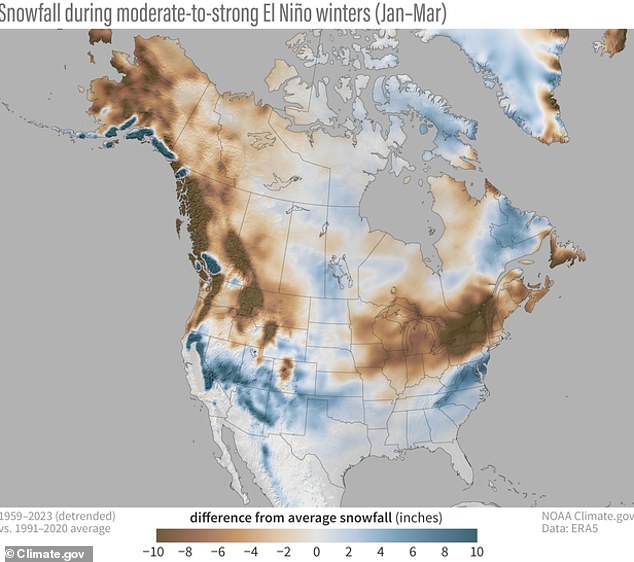
This NOAA map detailed how each area deviated from the average snowfall – with blue indicating more snow and brown indicating less snow.
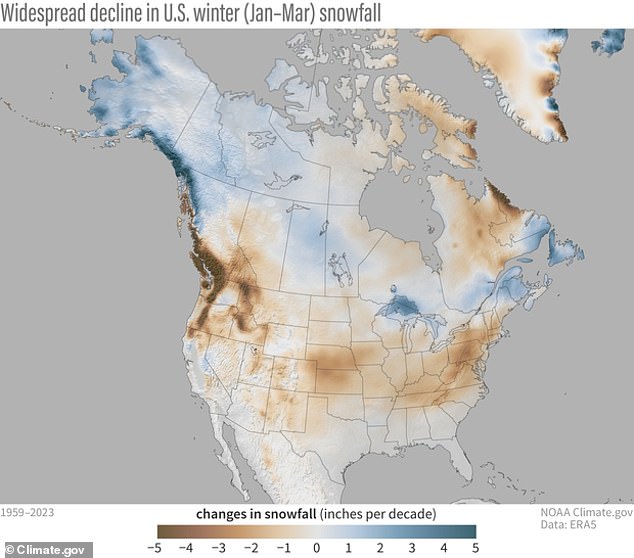
A third NOAA map showed changes in snowfall (in inches per decade) between 1959 and 2023 in the US – and indicated that snowfall has decreased overall
El Niño strengthens weather conditions – depending on its strength.
The NOAA The map detailed how each area deviated from the average snowfall – with blue indicating more snow and brown less snow.
During stronger El Niño winters, more snow falls than average in the US Midwest and western states such as Colorado, New Mexico, Arizona and Utah.
New England is seeing much less snow than normal during the intense El Niño seasons – New York, Vermont and parts of Maine are likely to see much less snowfall this winter than the 1991-2020 average.
Another card from NOAA represents the number of years with below-average snowfall during the thirteen moderate to strong El Niño winters that have occurred since 1959.
Dark red parts of the map indicated areas where there was below average snowfall more than half of the years, while the gray parts represent below average snowfall less than half of the time.
The dark red areas include parts of California, the Northeast and most of Florida. The rest of the US was on the grayer end of the scale, but most coastal areas were at least somewhat red.
A third NOAA The map showed changes in snowfall (in inches per decade) between 1959 and 2023 in the US – and indicated that snowfall has decreased overall.
The first snow of the season has already chilled the Rocky Mountains, Great Lakes and New England, resulting in the most extensive early November snow cover in at least two decades.
There was snow in 17.9 percent of the contiguous United States as of Wednesday morning, according to the National Oceanic and Atmospheric Administration.
At the same time last year, snow covered only 3.4 percent of the area. The 20-year average snow cover over the Lower 48 on November 1 is 5.5 percent.
Higher altitudes were warned last week to expect possible heavy snow, disrupting travel.
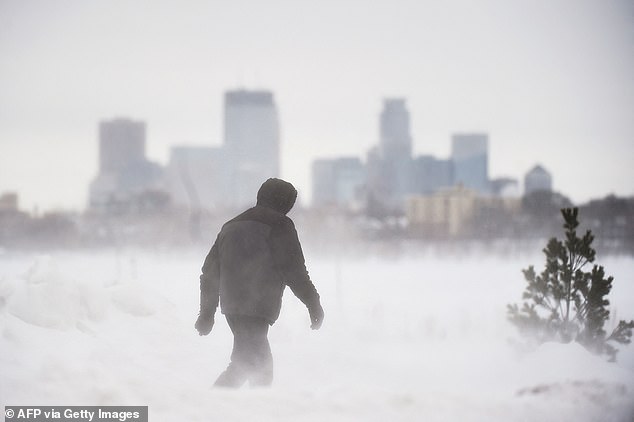
The shift is having a major impact on weather patterns around the world – and this year’s El Niño is expected to be the strongest since 2015 – which saw the warmest US winter on record (photo: a man takes a walk in front of the skyline Minneapolis at Bde Maka Ska Park during a snowstorm in Minneapolis, Minnesota, on February 22, 2023)
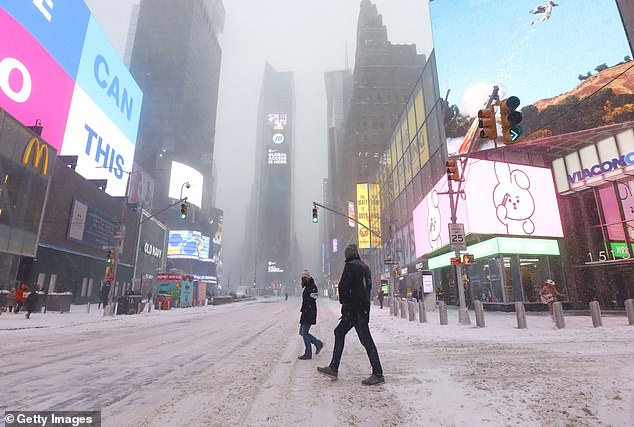
According to the National Oceanic and Atmospheric Administration, there was snow in 17.9 percent of the contiguous United States as of Wednesday morning (Photo: People walking along 7th Avenue in Times Square during a snowstorm on January 29, 2022)
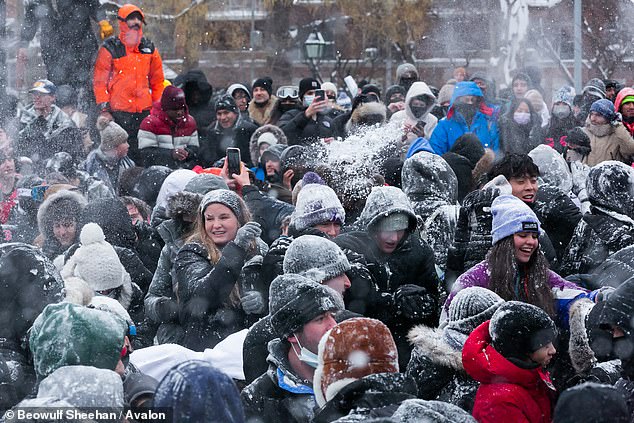
At the same time last year, snow covered only 3.4 percent of the area. The twenty-year average snow cover across the Lower 48 on November 1 is 5.5 percent (Photo: The public takes advantage of the winter snowstorm to enjoy a snowball in Washington Square Park with the Empire State Building in the distance)
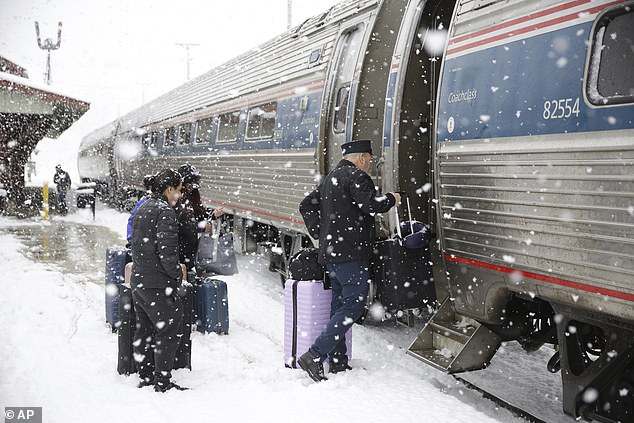
Last week, a storm moved out of the Pacific Northwest, covering the area from Montana to North Dakota with nearly a foot of snow and bringing cold air south (Photo: Conductor helps passengers board the southbound Amtrak Vermonter in Waterbury , Virginia, during a snowstorm on Tuesday, March 14, 2023)
Last week, a storm moved out of the Pacific Northwest, blanketing the area from Montana to North Dakota with nearly a foot of snow and bringing cold air south.
A second storm developed in the Rocky Mountains this weekend, burying Denver at depths of 4 to 10 inches.
The snowfall has been historic for some regions.
With 12 inches through Halloween, the city of Glasgow, Montana, has had its snowiest start to the winter season on record.
Bismarck, North Dakota, recorded just over 10 inches through the end of last month, marking the fourth-largest amount of snow to date.
